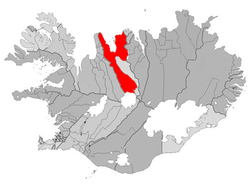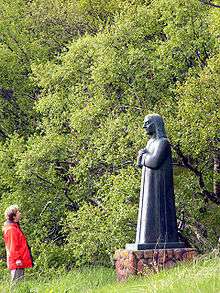Hólar
| Hólar | |
|---|---|
| Village | |
|
Hólar church | |
 Location of the Municipality of Skagafjörður | |
 Hólar Location of the Municipality of Skagafjörður | |
| Coordinates: 65°43′N 19°06′W / 65.717°N 19.100°W | |
| Country |
|
| Constituency[1] | Northwest Constituency |
| Region[2] | Northwestern Region |
| Municipality | Skagafjörður |
| Population (January 2011) | |
| • Total | 89 |
| Post code | 570 |
| Website |
www |
Hólar (Hólar í Hjaltadal) is a small community located in the Skagafjörður district and situated in northern Iceland.[3]
Location
Hólar is located in the Hjaltadalur valley, some 379 km (235.50 mi) from the national capital at Reykjavík. Hólar has a population of around 100. Hólar is the site of the main campus of Hólar University College, a site of historical buildings and archeological excavation, home to the Center for the history of the Icelandic horse, Hólar cathedral and the turf house Nýibær.
The first printing press in Iceland was introduced to Hólar in 1530. Hólar Agricultural College was founded 1882. The college was renamed Holar University College in 2003.[4]

History
Near the end of the 10th century, King Olaf I of Norway convinced all of his subjects to accept Christianity. He then sent missionaries to Iceland to convert them to Christianity which they quickly accepted. Around 1000 Iceland made a peaceful decision that all should convert. Despite this the godar or ruling class of Iceland, still maintained their power. Some built their own churches, and others were ordained.
Holar was the Episcopal see for northern Iceland (whereas Skálholt served the same function for southern Iceland), and a cultural and educational centre for almost seven centuries (1106-1798). Hólar was founded as a diocese in 1106 by bishop Jón Ögmundsson and soon became one of Iceland's two main centers of learning. Hólar played an important part in the medieval politics of Iceland, and was the seat of Guðmundur Arason in his struggle with Icelandic chieftains during the time of the commonwealth. Under Jón Arason Hólar was the last remaining stronghold of Catholicism in Iceland during the Reformation. The religious conflict was brutally resolved in 1550 when the last Catholic Bishop Jón Arason was taken to the south of Iceland and beheaded along with his two sons in Skálholt. The best known Lutheran bishop of Hólar was Guðbrandur Þorláksson. The present church was said to be fully constructed in 1763.
See also
Photo gallery
 Turf houses in Hólar
Turf houses in Hólar Church in Hólar
Church in Hólar
 Replica of Bishop's office
Replica of Bishop's office
Coordinates: 65°43′55″N 19°06′49″W / 65.73194°N 19.11361°W
| Wikimedia Commons has media related to Hólar í Hjaltadal. |
Sources
- This article incorporates text from a publication now in the public domain: Chisholm, Hugh, ed (1911). "Hólar". Encyclopædia Britannica (Eleventh ed.). Cambridge University Press.
References
- ↑ Political division
- ↑ Mainly statistical division
- ↑ Hólar - Valley Hjaltadalur - District Skagafjordur (NAT Nordic Travel Adventure)
- ↑ Hólar universitetshøyskole (Hólar University College)
